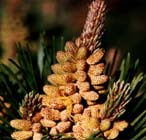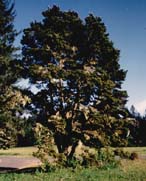 Trees growing in a peat bog on the Olympic Peninsula in Washington. P. contorta subsp. contorta is commonly found in bogs throughout its range [C.J. Earle, Apr-1999].  Active pollen cones of a specimen of subspecies contorta growing native at Patrick's Point, California [C.J. Earle, May-1999].  A specimen of subspecies contorta growing native at Patrick's Point, California [C.J. Earle, May-1999].  Two 3-5 m tall trees of subspecies contorta growing as ornamentals within their native range in Seattle (USA) [C.J. Earle, 19-Mar-1999]. |
Pinus contorta subsp. contorta
Common NamesShore pine (1).Taxonomic notesThe rationale for subspecies vs. varietal status is discussed under P. contorta. There is one variety, P. contorta subsp. contorta var. bolanderi (Parlatore) Koehne 1893 (syn: Pinus bolanderi Parlatore; P. contorta subsp. bolanderi (Parlatore) Critchfield).DescriptionTrees to 10 m tall and 50 cm dbh, straight or, in exposed sites, contorted and bent (ordinarily with a bowed base and then straight above 1 m), or reduced to shrub form by wind shear and salt spray in extreme exposure; mature crown irregularly rounded or flat. Bark irregularly furrowed, cross-checked into small, square or rectangular, orange-brown to purple-brown scaly plates. Branches spreading, often contorted. Leaves (2-)3-6(-7) cm × 1.2-1.8 mm, dark green, apex acute to broadly acute or blunt. Seed cones maturing and shedding seeds in 18 months, persistent or variously serotinous, 3-6.5 (-7.5) cm long, orange-brown, usually moderately to often strongly asymmetric and/or recurved, reflexed down branch, often in whorls, proximal outer apophyses weakly to strongly domed (1, 9).Var. bolanderi differs mainly in leaf anatomy, usually having no resin canals or rarely one (c.f. usually two in the type), and the cones average slightly heavier with thicker scales (3); it also differs in resin composition and genetic makeup (4, 5). It is more commonly a shrub, but this is an environmental effect due to poor growing conditions on highly podsolised white sands (6); when cultivated in Britain, its growth form is closely similar to the type (7). RangeUSA: Alaska, Washington, Oregon, NW California; Canada: British Columbia. Found in maritime fog forests, bogs, and dry foothills at 0-600 m elevation (1). Bog forest is probably the only ecosystem inhabited by Pinus contorta where it does not function as a highly fire-adapted species.Var. bolanderi is confined to the highly podsolised Mendocino white sands in California; see (6) for description of the vile growing conditions it has to tolerate, including minimal rooting depth above an impermeable hardpan, anaerobic winter flooding, severe summer drought and a soil pH of 2.9 (about as acid as vinegar!). Big TreeThe largest recorded specimen in its native range has height 31 m, dbh 112 cm, crown spread 11 m, found in Bryant, WA (2). Some comparably large trees exist in cultivation in Britain: 34 m tall at Bodnant, N Wales, and 114 cm diameter at Errol House, Scotland (8); these are planted on better quality soils than those accessible to the species in the wild where it is usually excluded on good sites by competition with Picea sitchensis, Pseudotsuga menziesii or other associates.Conversely, var. bolanderi is the smallest of all pines and among the smallest of all conifers, with sexually mature individuals as short as 20 cm recorded. OldestDendrochronologyEthnobotanyUSDA hardiness zone 7. This is one of the most important afforestation species in Britain, where its main uses are as a nurse for Picea sitchensis on poor and highly exposed sites, and for planting on coal-mining spoil heaps where it is one of the few trees that will grow successfully. It is often cut for Christmas trees, though it is not a good species for that purpose.ObservationsRemarksCitations(1) Robert Kral in Flora of North America online.(2) American Forests 1996. (3) W.B. Critchfield. 1957. Geographic variation in Pinus contorta. Maria Moors Cabot Foundation (Harvard) Publ. 3. (4) N.C. Wheeler & R.P. Guries. 1982. Population structure, genic diversity, and morphological variation in Pinus contorta Dougl. Canadian Journal of Forest Research 12: 595-606. (5) E. von Rudloff & M.S. Lapp. 1987. Chemosystematic studies in the genus Pinus. VI. General survey of the leaf oil terpene composition of lodgepole pine. Canadian Journal of Forest Research 17: 1013-1025. (6) S.N. Aitken & W.J. Libby. 1994. Evolution of the pygmy-forest edaphic subspecies of Pinus contorta across an ecological staircase. Evolution 48: 1009-1019. (7) M.P. Frankis, personal observations of trees at Kew Gardens. (8) Mitchell et al. 1990. (9) M.P. Frankis, personal observations, 28-Feb-1999 M.P. Frankis co-edited this page, Feb-1999. |
|
[Pinus] [Pinaceae] [home] This page is from the Gymnosperm Database
|